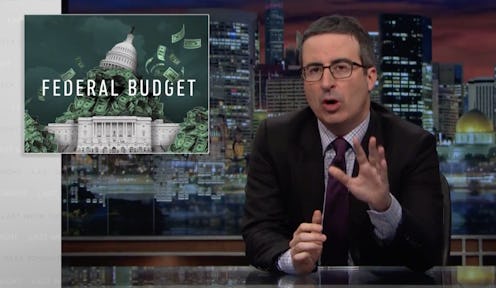News
John Oliver Took On Trump's Budget Proposal

President Donald Trump said back on the campaign trail that he was going to run America like a business, and John Oliver explored his plans to do just that on Last Week Tonight Sunday. The Trump Administration released its budget proposal last week, pushing for drastic cuts in agencies like the EPA and the State Department. In his main segment, Oliver broke down Trump's budget proposal, where it came from, and exactly who would get the short end of the stick under the plan. Surprisingly, many of the cuts hurt Trump's own supporters.
To get a look at what parts of government are getting more cash versus more cuts, Oliver played a segment of Wolf Blitzer on CNN. The news anchor splashed the Department of Defense, Homeland Security, Veterans Affairs, and the Social Security Administration on the screen. These get an injection of funds. Then the long list of programs on the chopping block began to scroll down the screen: the EPA, State Department, Agriculture Department, Labor Department, and so on and so forth. "The list goes on and on," Blizter said, which brings us to Oliver's take:
It's so fitting that the list of budget cuts scroll by the like the end credits for America. Thanks for helping us out, Agriculture Department! Hope you find a gig with the next country that rises from our ashes.
But how did the administration come up with these numbers? The cuts seem harsh, even to the point that some Republicans have called them draconian. Well, to explain it to the country is White House Budget Director Mick Mulvaney. Oliver looked at the "highly scientific process" that Mulvaney used to put the budget together. Essentially, Mulvaney watched Trump's campaign speeches to get an idea for the president's priorities and then added numbers.
"Basically, Mulvaney treated Trump's past statements the way Trump treats women: randomly singling out a few of them and then reducing them down to numbers," Oliver explained.
But how do you even do that? "Translating the noises that come out of Trump's face into hard policy prescriptions is almost impossible," Oliver pointed out. For example, the Defense Department is seeing a $52 billion increase, while Trump said this on military spending: "You've got to make the country rich again and strong again so that you can afford military and all of the other things." Not exactly clear, is it?
Then Trump said Russia's nuclear capabilities are "tippy top" and called for increased nuclear spending. Oliver's translation: "Let's trickle dickle some money bunnies into our boom boom budget. We're aiming for tippy top people because remember we're talking about the most lethal weapons in the history of mankind, so if we can, tippy, tippy top."
There's more to it, though. Even if Trump did talk about military spending and hate on the EPA publicly during the campaign, there are other parts of the budget that seem to be a contradiction to Trump's views. When it comes to rural social spending, the budget clearly goes against what Trump said in speeches, hurting the people who voted for him.
Rural airports are an example of this. Government money keeps many of them open, but Trump plans to cut that. Ironic, no? "Trump's rise was fueled by people in red states who were justifiably irritated that liberals sometimes refer to them as 'flyover country.' But this budget could literally turn some of them into flyover country, because there would be no other option," Oliver said.
One thing that's important to point out is that these cuts may not come to pass. This is a starting point, a look into Trump's ideal world, a wishlist of Trump's priorities. "This budget is simply a blueprint, what's known in Washington as a 'skinny budget,' which sounds like a line item Trump might have included in one of his prenups," Oliver joked.
Rather it's a "presidential mood board," Oliver suggested. Unfortunately for most Americans, Trumps mood "can always be described as impatient, vain, and horny for malice." That doesn't bode well, but hopefully between now and May when the final budget is introduced, even more Americans will be ready to resist.
Image: Last Week Tonight/HBO